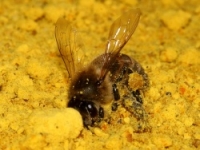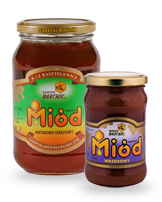Mixed flower honey
As the name indicates, this kind of honey is made from the nectar collected by bees on variety of plant, not only crops but also on those that grow on meadows, in forests, in the lowlands and in the uplands. It has a light cream colour, sometimes tealike. It crystallizes quite fast, changing its colour into light gray or light brown. It is characterized by quite strong smell that reminds the smell of beeswax and its flavour depends on the nectar mixture brought to a beehive. Its healing properties also depends on the plant selection made by the bees while collecting.
Mixed flower honey is ideal for treatment of allergies since it contains flower pollen that acts as an antigen.
Dandelion honey
Nectar used for production of this honey comes from Dandelion (
Taraxacum) that is also used in herbalism. It has light yellow colour, sometimes even light orange. It is characterized by the smell of Dandelion flowers.
Dandelion honey contains, found in Dandelion flowers, choline and that is why it is perfect for treating liver and bile canals ailments.It is also used in cases of anemia and physical and psychological exhaustion.
Oilseed rape honey
This kind of honey is the effect of processing by bees the nectar from oilseed rape. When fluid it is almost colourless or it has the colour of straw. After crystallization, which due to the high content of glucose happens extremely quick, it becomes cream white in colour and with slimy consistency. It has got faint smell of oilseed rape flowers.
Oilseed rape honey is recommended tith the circulatory disorders, in particular sclerosis. It balances the level of potassium in the system, decreases blood pressure and improves the nutrition of the heart muscle with oxygen and elements.
It is beneficial for treating skin diseases as, when applied externally, it prevents creating scald blisters and minimizes the risk of infection. It accelerates the healing process. It also has a positive influence on treating liver and respiratory system diseases.
Acacia honey
Pure acacia honey, made from nectar collected on the acacia flowers, happens to be colourlees or light cream. After crystallization prolonged by the large amount of fructose, it gains the straw colour. Its pleasant smell reminds of acacia flower.
Acacia honey is applied in treating stomach and duodenal ulcers as it accelelerates healing of sores and ulcers.
It is also used in hyperacidity, intestines inflammations and contractions because it improves their peristalsis.
Buckwheat honey
Used for production of this honey nectar comes from the flowers of buckwheat. It has dark colouring, often brown and even black under the influence of light. While crystallizing, it creates hard, thick crystals suspended in honey plasma. It has pungent smell and flavour, to some extent searing. It is the only kind of honey that contains large amounts of easily assimilable magnesium that is why it is recommended in treating cancerous diseases.
It gives good results to administer buckwheat honey in preventive treatment of sclerosis. It also improves the work of heart muscle.Recommended also for sight, hearing and memory impairment.
Linden honey
Linden honey is the product obtained by bees from the nectar of lime flowers. In liquid state it is the colour of light amber or yellow-green. After crystallizing it has got fine-grained consistency and becomes golden or white-yellow in colour. Linden honey has pleasant smell of lime flowers.
It is traditionally used in cases of severe and chronic respiratory diseases.Just like lime, it has expectorant and antipyretic properties. It has calming and antispasmodic effects. Linden honey is characterized by extremely strong antibiotic effect, especially effective in cases of urinary system infections. It is also administered in neurosis.
Heather honey
Acquired from heath flowers nectar, characterized by specific organic features and smell, it is used by bees to produce one of the most precious honey variety. When liquid it is red-brown. After cystallization, which happens rather fast, it becomes jellylike. It has got strong and specific smell of heath flowers. Its flavour is not sweet, even slightly bitter. In comparison to other varieties, it contains more vitamins and mineral elements.
Heather honey is recommended when dealing with urinary system diseases. It helps treating prostate ailments and nephrolithiasis. It if highly beneficial for curing intestines inflammation and diarrhea.
Honeydew honey
Honeydew honey is the honey product that contains honeydew from broadleaved and coniferous forests. It could be gree-gray, brown and even black as it depends on the type of the tree from which the honeydew is obtained. It crystallizes quite slowly and it becomes lumpy. It has got slightly spicy scent. Its flavour is delicate and not very sweet. Coniferous honeydew honey has anti-inflammatory, antiseptic and antibiotic effects. It contains more than nectar varieties active substances, including iron.
It is used in respiratory diseases and lowered immunity. It also helps to treat rheumatic, skin and nervous system ailments.
Broadleaved honeydew honey has similar effect. However, thanks to the diuretic properties it is better for curing urinal and rheumatic diseases. It also has the diastolic effect and that is the reason it is recommended in diseases of liver, intestines and bile canals.
Honeydew-nectar honey
This mixed honey is produced by the combination of different flowers nectar and honeydew. Thanks to this its diverse ingredients and high nutritious content. It has greenish or brown-green colour before crystallizing and after light or dark brown. Its flavour depends on plant from which the material was acquired. This variety demonstrates strong antibiotic properties, especially when it comes from mountainous areas, located 1000 m. above the sea level.
Mixed honey is perfect for treating physical and psychological exhaustion, heart diseases and digestion disorder.
Read more »






